The creative spark of a public employment programme
Introduction
The Presidential Employment Stimulus (PES) was launched in October 2020 in response to the pernicious impact of the coronavirus pandemic on employment. Its aim is to protect jobs and livelihoods while the labour market recovers, while creating new jobs and supporting people to create work of their own.[1] Since its launch, the PES has created more than one million jobs and livelihood opportunities through a mix of public employment, livelihood support, and job retention programmes, with the participation of 15 nationaldepartments.[2]
The PES provided support to the arts and culture sector, including through a stimulus to create employment managed by the National Arts Council and the National Film and Video Foundation on behalf of the Department of Sport, Arts and Culture (DSAC). This is known as the Presidential Employment Stimulus Programme (PESP). More than 30 000 people in the sector have benefitted directly from the PESP, which has provided opportunities to continue to work, as well as for new creative work in a sector badly affected by lockdown.
Kate Philip, Programme Lead for the Presidential Employment Stimulus, explains the rationale for the approach taken: “Many people in the creative sector are self-employed in the gig economy or run small enterprises. The main aim was to help them get back on their feet. So rather than a classic public employment programme – which would have removed them from these forms of economic activity – they were invited to propose ways to create employment for themselves and others in the sector. In the process, a wide range of new creative work was also supported.”
This article examines the economic stimulus effect of the PESP. An explicit aim of the PES is to contribute to wider economic recovery through the multiplier effects of local spending it enables.[3] ‘Stimulus effect’ refers to the economic impact of the programme beyond its direct recipients and is important in a context in which fiscal constraints – not least those associated with a pandemic - require social programmes that encourage multiple rounds of spending in the economy, thereby influencing the pace and composition of economic growth. An average of 70% of the funds spent in participating stimulus programmes is paid directly to beneficiaries.[4] The National Minimum Wage was used as the preferred benchmark for new programmes. Where the stimulus supported expansion of existing programmes, such as environmental programmes, the existing wage rates were applied.[5] The PES conducted a study to ‘follow the money’ within the creative sector in the first phase of the programme, focusing on its effects on direct recipients but also exploring trickle-up effects in the wider economy.
Below we provide a summary of the study’s findings: an overview of the functioning of the creative sector PESP and its employment outcomes, an outline of the methodology used to conduct the research, and a discussion of its outcomes.
PESP in the Sports, Arts and Culture Department: an overview
The National Film and Video Foundation (NFVF) and the National Arts Council (NAC) were tasked with administering the funding on behalf of DSAC. The funding package had job creation and retention components that applied to organisations, institutions, small and medium enterprises (SMEs), and individuals in the creative and cultural industry. This typically includes artists, creative, heritage, and cultural sector workers. Applicants had to demonstrate innovativeness in their proposed projects - which included market-access opportunities and digitisation efforts, transformation requirements, and on creating work opportunities in underserviced provinces or metros.
Together, the NFVF and the NAC received R6,95 billion worth of applications from the sector against a net budget of R440 million. This illustrates the significant scale at which the sector, with the necessary support, could create jobs.
Because the PESP was so oversubscribed, the implementing agencies faced serious challenges in selecting projects that best fit the criteria. A total of 1 543 beneficiaries received funding in the first phase of the PESP from October 2020 to February 2022, resulting in the creation of 32,145 work opportunities.[6]
Survey
A survey of the PESP Phase 1 beneficiaries was conducted between September and October 2022. From the population database of 1 534 beneficiaries, a sample of 411 beneficiaries was surveyed using a simplerandom sampling method. This was to ensure that each beneficiary had an equal and fair chance of being selected into the sample, thereby eliminating the bias associated with selecting ‘big’ projects over ‘small’. This was so ‘big’ projects’, which would be expected to create more work opportunities and thus have larger stimulus effects, could not potentially skew the results of the research. The simple random sampling established that beneficiaries were spatially represented, ranged from 18-67 years-old, and comprised males, females, and non-binary persons
Fifty-nine (59) questionnaires were completed and returned, and descriptive statistics and content analysis were used to analyse the data. In addition to the survey, interviews with the programme managers of the respective agencies were conducted for information on budgets, employment outcomes, and the overall functioning of the programme.
The major limitation of the study is the low rate of respondents who participated - only 59 of the intended 411, or 14%. Contributing factors to the low response rate were that the survey was not offered in more than one language – which restricted non or limited English-speaking respondents from participation. It is therefore recommended that future surveys be offered in multiple languages. Another factor is that some respondents had changed their contact details since Phase 1. It is recommended that the survey be done as early as possible, preferably as part of the reporting phase required by implementing agencies.
Beneficiary characteristics
Most beneficiaries applied in their capacity as companies (48%), followed by non-profit organisations (NPOs) (27%), and self-employed individuals (25%). The nature of funded projects was vast, ranging from film and television productions to poetry festivals, craft making, and music productions. This included the production of a film that won awards at the New York African Film Festival, another that obtained streaming rights on Netflix, and a literacy project that was awarded the United Nations Educational, Scientific and Cultural Organization (UNESCO) King Sejong Literacy Prize.
The majority of beneficiaries – 73% - used the funds to save existing jobs and support employment activities that existed before the pandemic. Beneficiaries that used their funds for retention purposes, said they had retained between one and nine jobs/employment activities.
Who did the PESP support?
Survey participants were asked about the type of employment and/or work opportunities that PESP funds had helped them support. They could select more than one option, as Figure 1 shows. While most said they had used the funds to retain existing jobs, 64% said they created new work opportunities that their entities had not supported before.
Figure 1: Forms of employment and/or work opportunities supported by the PESP
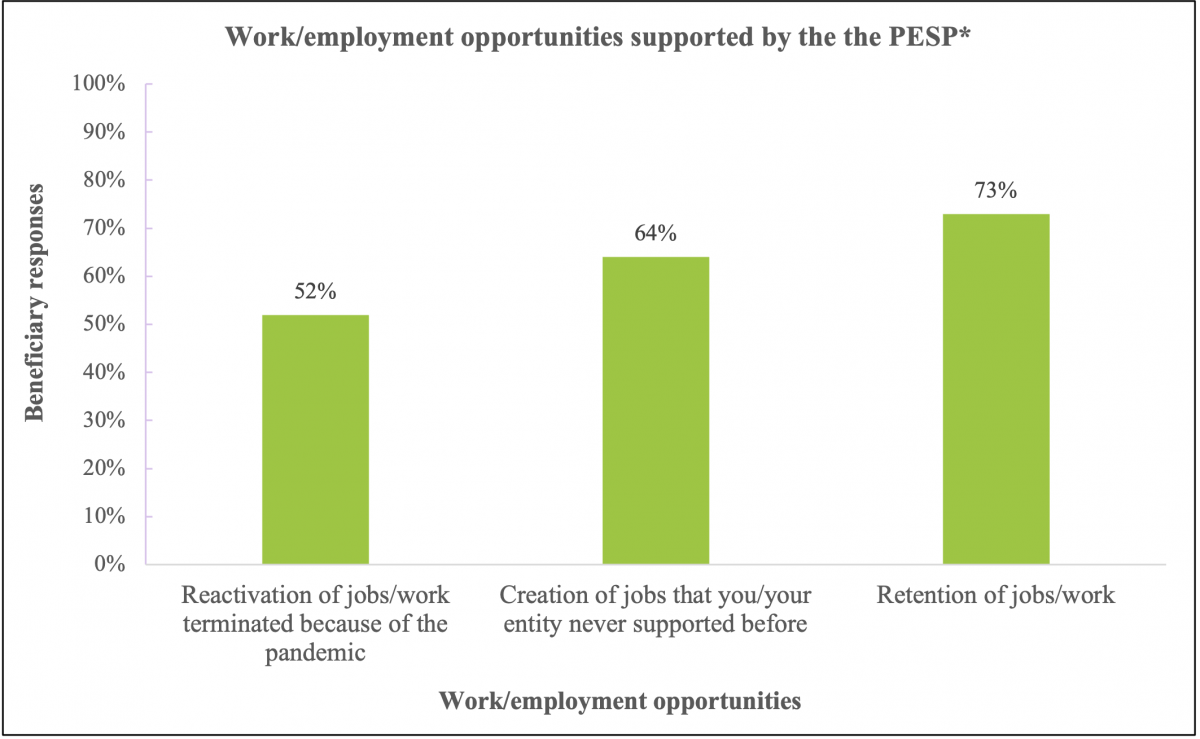
*Percentages do not add up to 100% as beneficiaries could choose more than one applicable answer
Of the jobs created, 42% of beneficiaries said some of these had become permanent placements. The modal number[7] of permanent jobs was five.
Sources of funding
While there was no limit for the funding amount per project, a funding structure applied. The PESP funding structure allowed no more than 50% of total funding to go to costs other than direct employment, which meant that for some beneficiaries, complementary funding was required. Therefore, the research sought to ascertain whether beneficiaries had additional sources of funding for their projects, as well as the forms of their funds. As illustrated in Figure 2a, the majority of respondents (64%) replied that the PESP was their sole source of funding. Figure 2b shows the types of funds for those who had additional funding. Most of these beneficiaries (62%) stated they were able to supplement their PESP funds largely from other grant funding[8], followed by funds from family and friends (43%) and finally from loans (19%). Note that respondents could select more than one funding option applicable to them from the responses available.
Figure 2: Alternative sources of funding
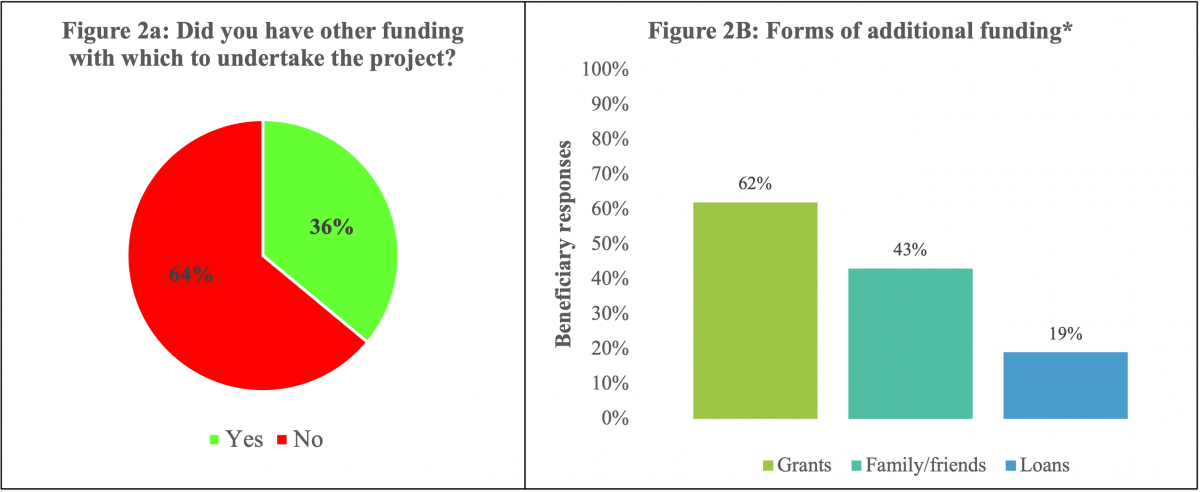
*Figure 2B: percentages do not sum to 100% as beneficiaries could choose more than one applicable answer
Interesting, too, was the extent to which PESP funds could be used to leverage additional funding. As Figure 3a illustrates, the PESP constituted a significant portion of the total funds required to undertake projects. Nearly half (43%) of beneficiaries stated that their PESP funds comprised 51-75% of total funds. About one third (29%) said PESP funds comprised over 75% of total funding. A total of 28% of beneficiaries said the PESP funding comprised less than 50%,[9] but they used their PESP funds to crowd-in additional funding. In terms of the leveraging capabilities of the PESP, Figure 3b shows that the PESP was helpful in raising additional funds required for undertaking projects - as shown by the 57% of beneficiaries who indicated this. The balance of beneficiaries (24%) stated they had already secured other funding without having to leverage the PESP, while 19% said they used only their own existing funds.
Figure 3: The ratio of PESP funds to total funds and their leveraging abilities
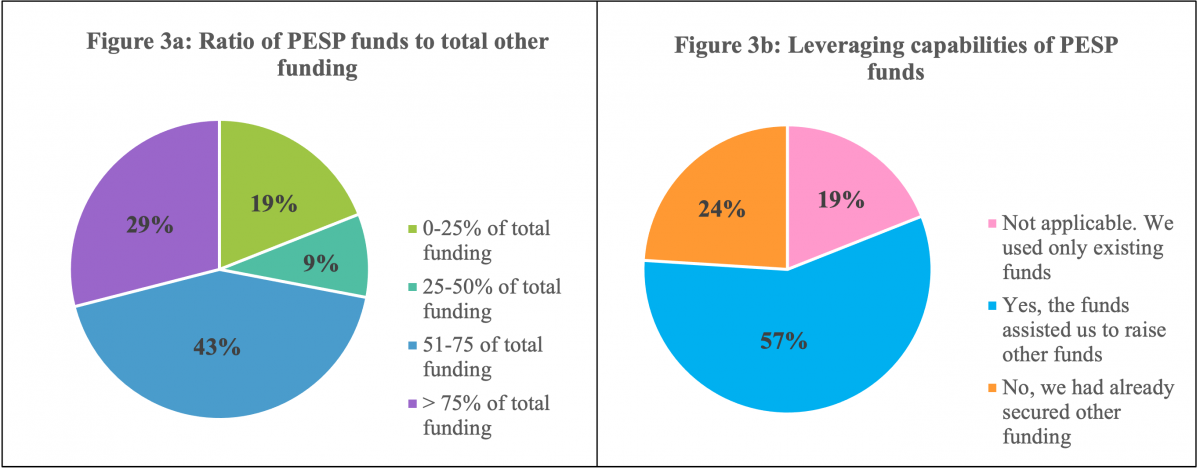
Challenges and opportunities
The beneficiaries were asked what challenges the PESP funds helped them to address and what opportunities they created. Expansion into new areas (69% of beneficiary responses) and the digitisation of work to access new markets (62%) were the most selected areas of opportunity.
One respondent said: “My film was awarded ‘Best Short Film’ at the New York African Film Festival. This allowed me to travel to the USA and attend in person. It helped me secure distribution rights and now I am on my way to shooting my first feature film.”
Another said: “PESP funding helped me to establish another branch, which expanded our production. It helped our business to participate in local, national and international exhibition[s].”
The most cited challenges related to cashflow (59%) and the lack of funding for new work (76%).
For example, one respondent wrote: “The PESP came at the absolute right time and enabled me to make the [movie] sequel “Happiness Ever After”, now streaming on Netflix in 190 countries to over 200 million subscribers.”
Another said: “[PESP funding] ignited most of filmmakers that had no chance to get opportunities to start their careers.”
Albeit cited less, the lack of work in the sector, lack of funding to complete existing work, cancellation of contracts due to the pandemic-induced lockdown, potential insolvency, and non-payment by creditors due to the lockdown were other challenges that the PESP was useful in addressing.
Stimulus effects
Beneficiaries were also asked to identify ways in which their PESP funds contributed indirectly to the creation of work or to the support of businesses outside and/or in the creative sector. Figure 4a illustrates the contribution of PESP funds to sectors outside of the creative sector. The trade, catering, and accommodation sector benefitted the most: 40% of beneficiary responses indicated having created work or supported businesses in the sector. Examples of this included (but were not limited to): the purchasing of film-production set equipment from retail stores, hiring catering companies for outdoor film festivals, and overnight stays in hotels and guesthouses for off-site production locations. This was followed by an indirect contribution of work to finance, real estate, and businesses services (30%), such as hiring accountants, lawyers and information technology specialists; transport, storage and communication sector – examples included using e-hailing services and the taxi industry (20%) - and finally, manufacturing and the personal services sector.
Figure 4: Contribution of PESP funds to sectors in and outside the creative sector
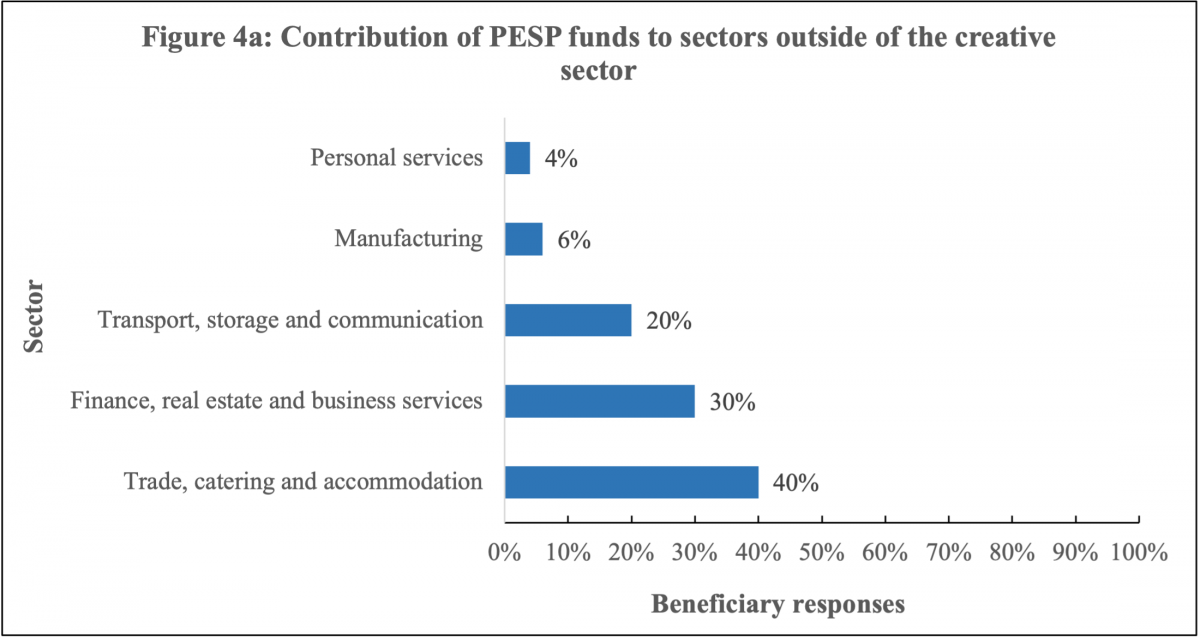
Within the creative sector, 44% of beneficiaries indicated that their PESP funds contributed indirectly towards paid work for musical collaborations, as well as towards supporting aspiring film producers and scriptwriters to start their own film-related businesses (at 56% of beneficiary responses).
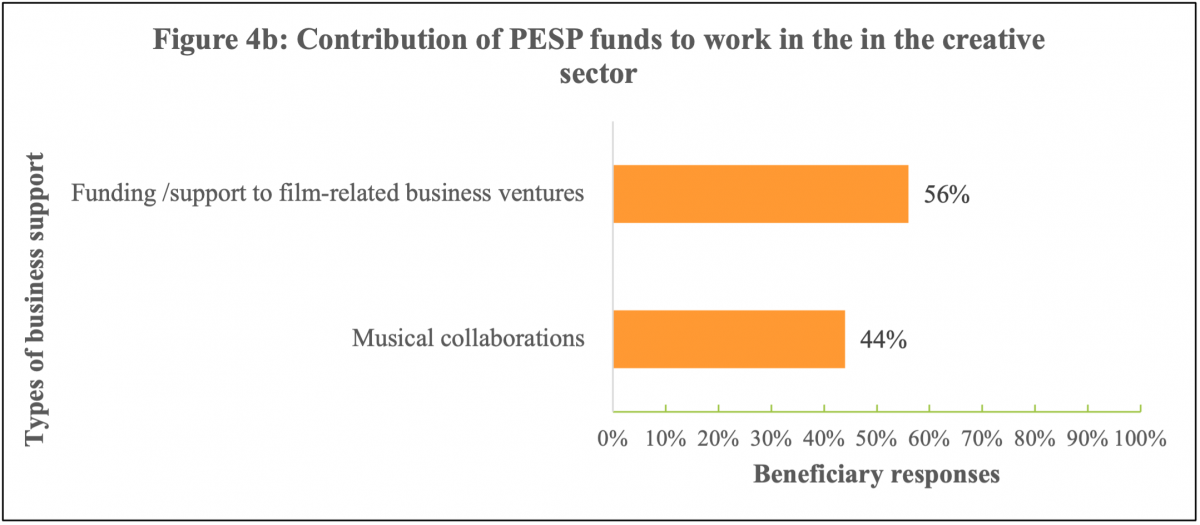
Finally, the survey shows that 78% of respondents were able to unlock additional income streams that helped sustain their livelihoods and businesses beyond the planned PESP project timelines. As illustrated in Figure 5, this additional income was predominantly in the form of sales from work produced (at 50% of beneficiary responses), followed by ticket sales (20%), and the sales of rights and royalties (at 30%).
Figure 5
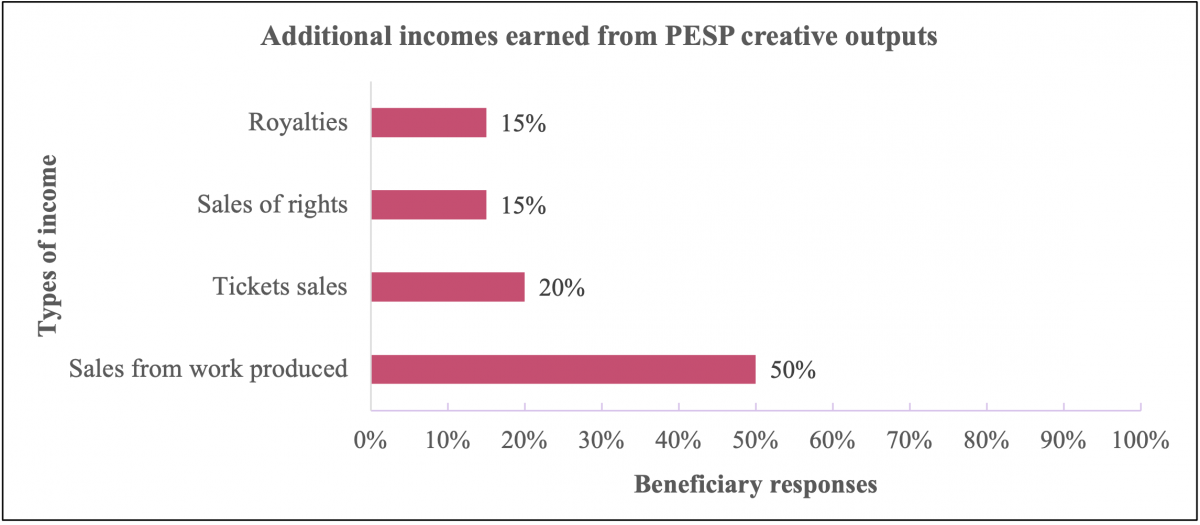
New opportunities
The PESP-supported projects undertaken by companies, self-employed people, and NPOs within the arts and culture sector were intended not only to retain the jobs of those who had worked prior to the pandemic, but also to create additional work. A significant majority of beneficiaries were able to create forms of work they had not supported before, with 42% of these saying that some of the work extended beyond the project period. This result is particularly encouraging, given that the PESP was short-term support. It illustrates the extent to which beneficiaries were able to leverage the support provided to secure opportunities and to sustain jobs created beyond the project period.
A significant majority of beneficiaries did not have additional funding outside of the PESP grant and for the few that did, their PESP funds constituted 51-75% of their total funding. So not only was the PESP grant a critical funding injection, but it was also a catalytic grant, with strong leveraging abilities that enabled the crowding-in of more funds.
The PESP grants were most useful for giving beneficiaries the opportunity to expand into new areas of work, such as participation in national and international art exhibitions and obtaining television streaming rights, which advanced their careers. An additional opportunity was in the digitisation of work, which enabled beneficiaries to access new markets. The PESP grant was most useful for addressing cashflow problems as well as the lack of funding required to start new work.
The PESP had stimulus effects both within and outside the creative sector. For the latter, it (indirectly) contributed to work in the trade, catering and accommodation sector; finance, real estate and businesses service sector; and the transport, storage and communication sector. The work created was not only in the formal sector but also in the gig economy – as indicated by beneficiaries' use of e-hailing services - and the informal economy – as indicated by beneficiaries whose projects were located in townships and rural areas, resulting in the purchase of food from street vendors or using minibus taxis. Within the creative sector, the funds contributed towards work for other music artists through musical collaborations, as well as support for new business ventures of aspiring filmmakers.
A further stimulus effect was evidenced through the additional incomes made possible by PESP funds. The PESP funds opened additional income streams, largely in the form of sales of work or ticket proceeds, which enabled most beneficiaries to sustain their livelihoods and businesses.
Finally, while the employment created was publicly funded, the PESP responded to the reality of the sector by creating an enabling mechanism of support that put the initiative in the hands of the sector to create employment for themselves through generating new work, rather than a public employment model with a more traditional employment relationship.
Conclusion
The creative sector PESP was designed to support job creation and livelihood opportunities in the arts and culture sector. As this study has shown, the sector seized this opportunity - creating employment and supporting livelihoods not only in the creative sector, but also in the wider economy through the multiplier effects of the funding. In addition to extensive direct impact, the stimulus also trickled up into diverse value chains. This resulted in support for not only the formal economy, but also the informal economy and small enterprises, reaching township and rural economies that are otherwise often by-passed. Furthermore, where additional income was earned from the work produced with PESP funds, this had the impact of further contributing to the total output of the creative sector and/or to household spending, thereby increasing the share of the sector and of household spending to national gross domestic product.
The scale of response was significant, highlighting not only the scale of need but also of opportunity for job creation in the sector. In addition to proving there is no shortage of work to be done in the sector, the study has also shown that state support in employment creation can take different forms. In this instance, the PESP as an incentive model allowed state support to take a catalytic form – rather than the state acting as the employer in a more traditional public employment model. The model of support focused on sparking initiative from the sector. It allowed the sector scope to drive the nature of the work created and, in many instances, leveraged new and additional opportunities.
Finally, despite its short-term nature, the PESP allowed beneficiaries to create longer-term employment opportunities, as illustrated by jobs that were sustained beyond the project period. This has the benefit of strengthening skills development, creating greater access to networks and information, and enhancing workers’ self-confidence. In this way the PESP has, in addition to job creation, further contributed to employees’ employability skills – skills crucial for performing work in any sector.
References
Philip, K. 2020. Proceedings of the conference on “The Presidential Employment Stimulus: Research Opportunities”. Science Forum South Africa, Pretoria: Academy of Science South Africa (ASSAf) and Department of Science and Innovation (DSI). (https://research.assaf.org.za/bitstream/handle/20.500.11911/181/2021_assaf_proceedings_sfsa2020_presidential_employment_stimulus_research_opportunities.pdf?sequence=8&isAllowed=y)
Presidency, 2021. Building a society that works: The next phase of the Presidential Employment Stimulus. Assessment review. The Presidency, Republic of South Africa.
Presidency, 2022. State of the nation address 2022, Presidential Employment Stimulus dashboard. The Presidency, Republic of South Africa. (https://www.stateofthenation.gov.za/employment-stimulus-dashboard.)
[1] Presidency, 2021.
[2] Presidency, 2022.
[3] Presidency, 2021
[4] The balance goes to local input suppliers.
[5] Philip, 2020.
[6] The reported percentage of jobs for Africans was 86 and 77 for the NAC and NFVF, respectively. The balance was occupied by whites, coloureds and Indians.
[7] The most cited number
[8] Such as commercial and other government grants
[9] PESP funds that comprised less than 50% of total funding are broken down as follows: 19% of beneficiaries stated that the ratio of their PESP funds to total other funding was 0-25%; while 9% stated a ratio of 25-50%.
Download article
Post a commentary
This comment facility is intended for considered commentaries to stimulate substantive debate. Comments may be screened by an editor before they appear online. To comment one must be registered and logged in.
This comment facility is intended for considered commentaries to stimulate substantive debate. Comments may be screened by an editor before they appear online. Please view "Submitting a commentary" for more information.
